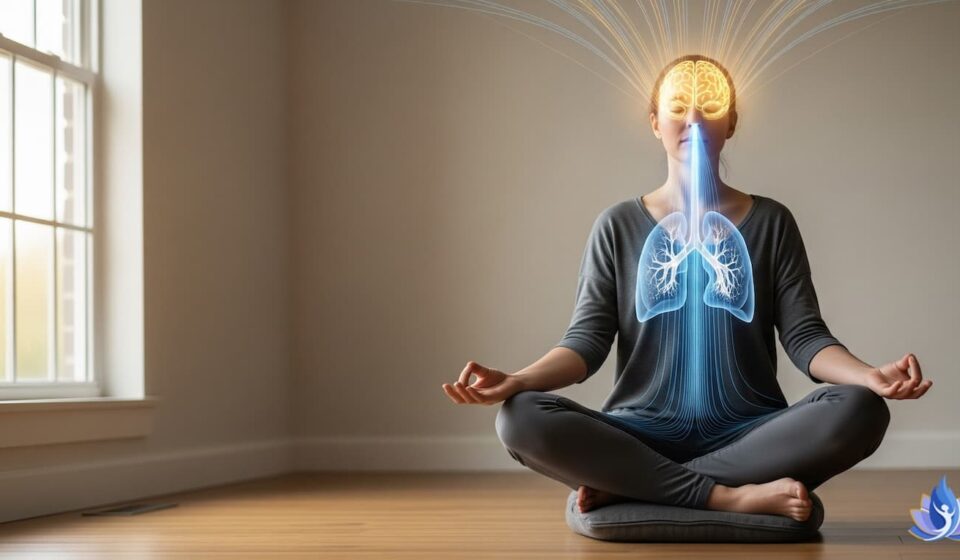In our hyper-stimulated modern world, stress and anxiety have become constant companions for many. We search for relief in apps, therapies, and medications, often overlooking a powerful tool that is with us every moment: our breath. For thousands of years, yogic sages have taught that the breath is the key to mastering the mind. This ancient art of breath regulation, known as Pranayama, is now being validated by modern neuroscience, revealing how these simple techniques can literally rewire our brains for calmness and resilience.
Table Of Content
Pranayama is not just about taking deep breaths; it is a sophisticated science of controlling the life force, or prana, to bring the body and mind into a state of balance. Scientific studies are now showing that these ancient practices have a measurable impact on our nervous system, brain activity, and stress hormone levels, making them one of the most effective, evidence-based tools for managing the pressures of modern life.
The Breath-Brain Superhighway: Your Autonomic Nervous System
Our body has a built-in stress management system called the Autonomic Nervous System (ANS), which has two main branches:
- The Sympathetic Nervous System (SNS): The “fight or flight” response. It prepares you for action, increasing heart rate and releasing stress hormones.
- The Parasympathetic Nervous System (PNS): The “rest and digest” response. It promotes relaxation, digestion, and recovery.
In our chronically stressed lives, the SNS is often in overdrive. Pranayama is a direct way to consciously activate the PNS. Slow, deep, and rhythmic breathing sends a powerful signal to the brain that you are safe, shifting you out of survival mode and into a state of calm. This is where the magic begins.
Activating the Vagus Nerve: Your Body’s Reset Button
Running from your brainstem to your abdomen is the vagus nerve, the main highway of the parasympathetic nervous system. A healthy “vagal tone” is linked to better emotional regulation and resilience to stress. Specific pranayama techniques are incredibly effective at stimulating this nerve.
- Ujjayi Breath (Ocean Breath): The slight constriction in the throat during Ujjayi breathing directly massages and stimulates the vagus nerve.
- Bhramari (Humming Bee Breath): The vibration created by humming has been shown to activate the PNS, sending calming signals throughout the body.
When you stimulate the vagus nerve through these practices, you are essentially hitting a physiological reset button, telling your entire system that it’s time to relax and repair.
Rewiring Your Brain: Pranayama and Neuroplasticity
Perhaps the most exciting discovery is that pranayama can physically change your brain. This ability of the brain to reorganize itself is called neuroplasticity. Consistent practice has been shown to:
- Strengthen the Prefrontal Cortex: This is the brain’s command center, responsible for focus, decision-making, and emotional regulation. Pranayama enhances its function, giving you greater control over your reactions.
- Calm the Amygdala: The amygdala is the brain’s fear center. Pranayama can reduce its reactivity, meaning you are less likely to be hijacked by anxiety and fear.
- Increase Gray Matter: Studies have shown that long-term yoga and pranayama practitioners have more gray matter in brain regions associated with self-awareness and emotional regulation.
The Hormonal Shift: Lowering Cortisol
Chronic stress leads to elevated levels of cortisol, the primary stress hormone, which can cause a host of health problems. Scientific reviews have confirmed that regulated breathing practices, such as slow diaphragmatic breathing and alternate-nostril breathing, can help regulate the body’s stress response axis (the HPA axis) and lead to a significant decrease in cortisol levels.
“Natural forces within us are the true healers of disease.” — Hippocrates
This ancient insight from the father of medicine perfectly captures the essence of Pranayama. By harnessing the natural force of our own breath, we tap into the body’s innate ability to heal and find balance.
Conclusion: The Power to Be Calm is Within You
The science is clear: Pranayama is a powerful, evidence-based practice for transforming your mental and emotional state. It is an ancient technology that allows you to consciously shift your nervous system, regulate your stress hormones, and even reshape your brain for greater peace and resilience.
You don’t need any special equipment or a quiet retreat. The power to find calm, clarity, and focus is already within you, accessible in every single breath.
The science of breath is a profound journey into our own biology and consciousness. Which pranayama technique do you find most effective for calming your mind? Share your experience in the comments below, pass this article on to someone who needs it, and follow us on social media for more wellness wisdom.

